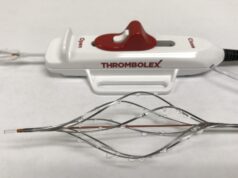
Results from a retrospective observational cohort study demonstrate reduced 30-day all-cause mortality, length of hospital stay and supplemental oxygen use at discharge in patients with intermediate-high-risk and high-risk pulmonary embolism (PE) treated with mechanical thrombectomy and anticoagulation following Pulmonary Embolism Response Team (PERT) consultation and recommendation, compared with those treated with anticoagulation alone.
Led by Ryan Nolan (University of Nevada, Reno, USA) et al, the authors report that mechanical thrombectomy use—particularly when PERTs are employed—has increased in recent years, however studies have shown that patients consulted by PERTs can receive “different care” to non-PERT patients, including more extensive cardiac workup and receive catheter-directed therapies, the research team explain.
The study, which was recently published in the Journal of Vascular and Interventional Radiology (JVIR), included 335 patients with PE who received PERT evaluation over 3.5 years—76 received mechanical thrombectomy and anticoagulation, while 259 received anticoagulation alone. Nolan and colleagues report that the use of mechanical thrombectomy was associated with reduced odds of 30-day all-cause mortality (odds ratio [OR], 0.49; 95% confidence interval [CI], 0.27–0.76; p=0.002).
Quantifying the associated mortality signal between treatments, the authors note that Cox proportional hazard ratio (HR) demonstrated a 36.4% reduction in the mechanical thrombectomy and anticoagulation group. Nolan et al continue that PE-associated mortality in this period was 17.8% in the anticoagulation-alone cohort compared to 9.6% in patients who received combined treatment. Further, PE-caused mortality was reported as 9.5% and 7.3%, respectively.
Overall median length of hospital stay was two days shorter in the combined treatment group, state Nolan and colleagues. They continue that, in high-risk patients who received mechanical thrombectomy and anticoagulation, length of hospital stay was reduced by 4.5 days, and two days for intermediate-high risk patients compared with anticoagulation alone. They note that, “importantly, there were no differences in readmission rates between cohorts, suggesting that discharge for patients in the [mechanical thrombectomy and anticoagulation] cohort was not premature”.
Nolan and colleagues go on to explain that the proportion of patients receiving supplemental oxygen at discharge was lower in the combined treatment group (4.1% vs. 18.5%; p<0.001), without significant differences in 30-day readmission rates (9.5% vs. 20.6%; p=0.115). They note that mechanical thrombectomy resulted in an 8.7mmHg reduction in mean pulmonary artery pressure, had a technical success rate of 100% and an adverse event rate of 6.6%.
In their discussion of the results and the relationship between mechanical thrombectomy and PERT consultation, Nolan and colleagues write that, alongside the literature, these data demonstrate mechanical thrombectomy is a “safe and rapid therapy” for PE and detail how previous studies “demonstrate that PERT implementation tends to increase the use of catheter-directed therapies for eligible patients”.
They acknowledge, however, that “scepticism” regarding the increasing prevalence of catheter-directed therapies for patients with intermediate-high–risk and high-risk PE who have been consulted by a PERT is “understandable”, and it is therefore “important to determine if the increased use of catheter-directed therapies is both safe and beneficial for patients”.
“Studies have demonstrated that PERT consultation is associated with increased use of catheter-directed therapies; however, there are conflicting data on mortality, with certain articles suggesting potentially improved 30- and 90-day mortality compared with non-PERT-managed patients, whereas others suggest no benefit. The utilisation of a multidisciplinary PERT in this study facilitated timely risk stratification and consensus-based treatment planning,” Nolan and colleagues write.
The authors acknowledge several limitations of their study, referencing its single-centre design as well as “significant variation” in PERT or institution protocol, team composition, mechanical thrombectomy technique and device utilisation. They note that these factors were “not necessarily controlled” in this study, and further, emphasise the nonrandomised nature of their investigation.










